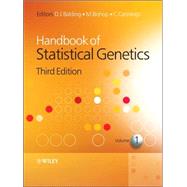
Note: Supplemental materials are not guaranteed with Rental or Used book purchases.
Purchase Benefits
What is included with this book?
Imperial College of Science, Technology and Medicine, London, UK
M. Bishop
CNR-ITB, Milan, Italy
C. Cannings
University of Sheffield, UK
| List of Contributors | |
| Editor's Preface to the Third Edition | |
| Glossary of Terms | |
| Abbreviations and Acronyms | |
| Genomes | |
| Chromosome Maps | |
| Introduction | |
| Genetic Maps | |
| Physical Maps | |
| Radiation Hybrid Mapping | |
| Other Physical Mapping Approaches | |
| Gene Maps | |
| Acknowledgments | |
| References | |
| Statistical Significance in Biological Sequence Comparison | |
| Introduction | |
| Statistical Significance and Biological Significance | |
| Estimating Statistical Significance for Local Similarity Searches | |
| Summary: Exploiting Statistical Estimates | |
| Acknowledgments | |
| References | |
| Bayesian Methods in Biological Sequence Analysis | |
| Introduction | |
| Overview of the Bayesian Methodology | |
| Hidden Markov Model: A General Introduction | |
| Pairwise Alignment of Biological Sequences | |
| Multiple Sequence Alignment | |
| Finding Recurring Patterns in Biological Sequences | |
| Joint Analysis of Sequence Motifs and Expression Microarrays | |
| Summary | |
| Acknowledgments | |
| Markov Chain Monte Carlo Methods | |
| References | |
| Statistical Approaches in Eukaryotic Gene Prediction | |
| Structural Organization and Expression of Eukaryotic Genes | |
| Methods of Functional Signal Recognition | |
| Linear Discriminant Analysis | |
| Prediction of Donor and Acceptor Splice Junctions | |
| Identification of Promoter Regions in Human DNA | |
| Recognition of PolyA Sites | |
| Characteristics for Recognition of 3-Processing Sites | |
| Identification of Multiple Genes in Genomic Sequences | |
| Discriminative and Probabilistic Approaches for Multiple Gene Prediction | |
| Internal Exon Recognition | |
| Recognition of Flanking Exons | |
| Performance of Gene Identification Programs | |
| Using Protein Similarity Information to Improve Gene Prediction | |
| Genome Annotation Assessment Project (EGASP) | |
| Annotation of Sequences from Genome Sequencing Projects | |
| Characteristics and Computational Identification of miRNA genes | |
| Prediction of microRNA Targets | |
| Internet Resources for Gene Finding and Functional Site Prediction | |
| Acknowledgments | |
| References | |
| Comparative Genomics | |
| Introduction | |
| Homology | |
| Genomic Mutation | |
| Comparative Maps | |
| Gene Order and Content | |
| Whole Genome Sequences | |
| Conclusions and Future Research | |
| Acknowledgments | |
| References | |
| Beyond the Genome | |
| Analysis of Microarray Gene Expression Data | |
| Introduction | |
| Data Visualization and Quality Control | |
| Error Models, Calibration and Measures of Differential Expression | |
| Identification of Differentially Expressed Genes | |
| Pattern Discovery | |
| Conclusions | |
| Acknowledgments | |
| References | |
| Statistical Inference for Microarray Studies | |
| Introduction | |
| Initial Data Processing | |
| Testing the Association of Phenotype with Expression | |
| Multiple Testing | |
| Annotation Analysis | |
| Validation Analysis | |
| Study Design and Sample Size | |
| Discussion Related Chapters | |
| References | |
| Bayesian Methods for Microarray Data | |
| Introduction | |
| Extracting Signal From Observed Intensi | |
| Table of Contents provided by Publisher. All Rights Reserved. |
The New copy of this book will include any supplemental materials advertised. Please check the title of the book to determine if it should include any access cards, study guides, lab manuals, CDs, etc.
The Used, Rental and eBook copies of this book are not guaranteed to include any supplemental materials. Typically, only the book itself is included. This is true even if the title states it includes any access cards, study guides, lab manuals, CDs, etc.